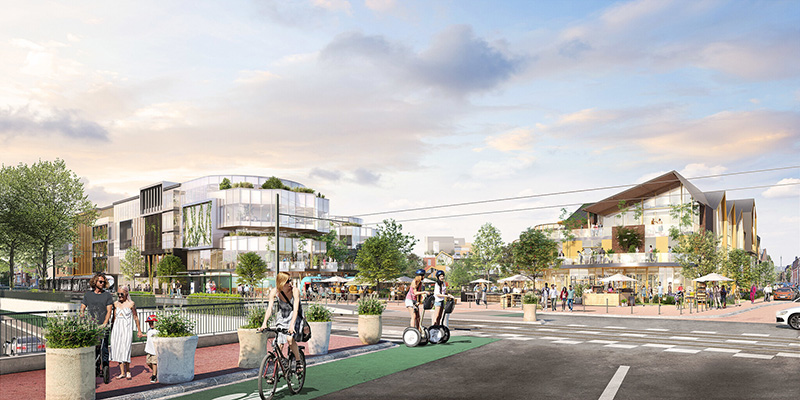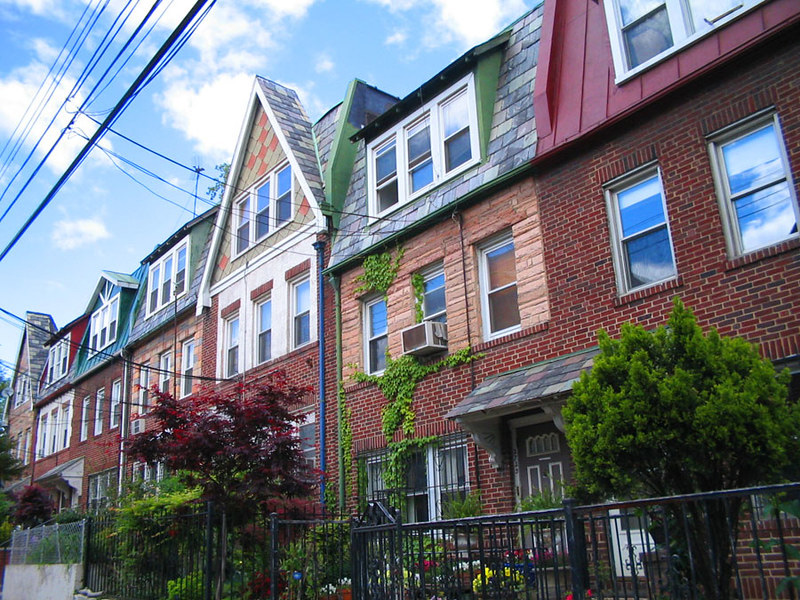Gentle Density Increases Nearby Property Values, Evidence Shows, Contrary to Popular Belief
| . Posted in News - 0 Comments
By Eric Weld, MassLandlords, Inc.
Resultant lowered property values are one of the main reasons given by opponents of zoning reform, which could introduce increased housing density. The cultural meme of more diversity and more people in a given neighborhood dragging down the value of properties there – especially single-family homes – is widely repeated and accepted among buyers and sellers.
But it’s wrong, according to numerous studies. And worse, for many U.S. cities it’s standing in the way of expanding housing stock, especially affordable housing.
In fact, in most cases, bringing “gentle” housing density into a residential neighborhood has been shown to increase property values if done wisely. This property value boost with increased density is partly due to lifestyle enhancements like added cultural opportunities, close retail outlets, lower infrastructure costs and shorter commutes, among other factors.
The phrase “gentle” density is gaining repetition in media. In contrast to high density, which includes mid- and high-rise residential buildings, gentle density refers to development of duplexes, triplexes, accessory dwelling units (ADUs), stacked townhouses, semi-detached homes and small-scale apartment and condominium buildings within and among single-family zoned neighborhoods. Gentle density promotes mixed-use development, with single-family homes alongside small multi-family homes, businesses and commercial buildings. Gentle density aims to retain neighborhoods’ residential identity and feel while alleviating housing crises.

According to dozens of studies, mixed-use neighborhoods such as this one, that combine retail, commercial and residential land use, bolster nearby property values.
Property Values Shown to Increase with Gentle Density
Studies abound with conclusive evidence that gently increased housing density provides at least a slight boost to property values. Not a single U.S. study has found that introducing gentle density negatively impacts values of proximate single-family homes or rental properties.
A 2012 study, “The Economic Value of Walkable Neighborhoods,” published in Urban Design International, concluded that the value of both single-family residential properties and multi-family rental properties increased with density of development. Part of that property increase was due to added amenities like sidewalks, shorter blocks, and a mix of retail, commercial and residential surroundings, the study said.
The study went further. Not only did cited properties increase in value, but the quality of neighborhoods – defined as access to parks and other land uses – increased, too.
The Ken C. Gardner Policy Institute at the University of Utah studied single-family home prices in suburbs around Salt Lake County between 2010 and 2018. “This study found apartments built between 2010 and 2018 have not reduced single-family home values in suburban Salt Lake County,” the study sums. “Single-family homes located within ½ mile of a newly constructed apartment building experienced higher overall price appreciation than those homes farther away.”
In addition to increased property values, higher density development yields several other benefits, according to MetroTex, an association of realtors analyzing housing density in the Dallas-Fort Worth metro region. Among them: lower infrastructure costs due to smaller, more compacted service areas; less traffic because residents in higher density neighborhoods tend to need or own fewer cars than their counterparts in lower density, single-family communities; lower taxes since higher density areas are more likely to spread tax assessments among mixed-use properties including retail and commercial; more efficient and cost-effective schools; and attractive circumstances for new employers.
Finally, but not exhaustively, an in-depth study, conducted in 2005 by the Urban Land Institute, examined several myths surrounding housing density. The study states: “Ample evidence... suggests that well-designed higher-density development, properly integrated into an existing community, can become a significant community asset that adds to the quality of life and property values for existing residents while addressing the needs of a growing and changing population.”
Yet, the study acknowledges, attitudes toward increased density persistently skew negative. Still, when people who object to the general concept of increased housing density are shown images of gentle density versus lower density, they prefer the benefits of gentle density communities and change their negative reactions to it. Amenities such as restaurants, schools, shopping, libraries and public transportation within walking distance are preferred to longer commutes and larger home lots with fewer opportunities for walking.
The Urban Land Institute study also reiterates that several studies have examined correlations between multi-family development and impact on property values of nearby single-family homes. “These studies have shown either no impact or even a slightly positive impact on appreciation rates,” the study concludes.
The study goes on to cite several other studies detailing percentage increase comparisons between properties near higher density development and those in low-density areas. Every study concludes that well-designed higher density increases overall values of nearby single-family homes.

Reforming local zoning policies and loosening density controls could usher in more gentle density developments like this one.
Impact of Gentle Density on Rent Rates
In addition to increasing property values, loosening housing density controls has the secondary benefit of reducing rental rates, according to this 2021 study conducted in Boston.
“We find that relaxing density restrictions (minimum lot size and maximum dwelling units), either alone or combined with relaxing height restrictions or allowing for multi-family housing, are the most fruitful policy reforms to increase supply and reduce multi-family rents and single-family prices,” state the authors – Nick Chiumenti of the Federal Reserve Bank of Boston, Amrita Kulka of the University of Warwick and Aradhya Sood of the University of Toronto – of the study, “How to Reduce Housing Costs? Understanding Local Deterrents to Building Multi-Family Housing.”
This trend aligns with conventional economic supply-and-demand theory. When the supply of a desirable product (housing in this case) is restricted, both perceived value and price logically increase.
A 2021 study by the U.S. Department of Housing and Urban Development corroborates the Boston findings, and goes further in concluding that the opposite is also true: tighter housing density controls and resultant low-density regions spur rising rents.
Where this standard economic model veers off course is in the above-described case of single-family property values, which increase with the development of gentle density – or more housing availability. However, studies point out that home prices and rents do not always correlate strictly around density, and are significantly influenced by other factors, as stated above.
Why Objection to Density Persists
It’s somewhat of a mystery why incorrect attitudes persist regarding higher density housing’s negative effects on property values.
It’s well-known that zoning originated as an exclusionary tool, to keep non-white, foreign and lower-income people from moving into certain neighborhoods. Exclusionary zoning persisted long into the 20th century – and is still with us – largely on the premise that allowing non-white and poorer populations into neighborhoods would harm property values. While some communities work to move beyond these prejudices, it’s likely some of that belief and attitude remain today.
Still, no modern study has investigated the persistent, but errant, collective attitude that gentle density negatively impacts property values. In fact, property values are shown to be based more on practical considerations and life-enhancing opportunities than on density and diversity. Proximity to amenities, specific architecture and good building maintenance, and the availability of quality infrastructure and services are the high-ranking qualifiers determining property values.
Stubborn myths about the negative effects of housing density may also be largely due to leftover memories of high-density, high-rise urban housing projects of the 1960s and 1970s. Housing projects in New York City, Chicago and other cities were broadly deemed failures as models of denser housing. The failure label was certainly unfair, as those projects were doomed with high concentrations of poverty, poorly funded and performing schools and low opportunity for employment, not to mention a dearth of life-enhancing amenities like green spaces. As a result, many of these developments became riddled with relatively high crime, though that was not a direct corollary with high density. Systemic racism also played a heavy hand in the failure of high-density housing projects.
Today’s mixed-use, gentle density developments are a stark contrast to those high-density projects with emphases on multi-family architecture, green space, mixed-use zoning and low car traffic.
Nonetheless, the perception of high density as a failed housing policy may be partly souring the public attitude toward low and medium density.
At least equally as important are individual prejudices against dense housing – i.e., the NIMBY effect – which continue to be prevalent across demographic categories. “Across every demographic subgroup analyzed, respondents preferred single-family home developments by a wide margin,” writes Jessica Trounstine in a December 2021 article for Urban Affairs Review. “Relative to single family homes, apartments are viewed as decreasing property values, increasing crime rates, lowering school quality, increasing traffic, and decreasing desirability.”
Yet none of those beliefs are true, according to dozens of studies.
National Attitude Change Needed
Cities across the United States consistently have a housing shortage. On that fact there is broad agreement. Some 83% of the U.S. population now lives in urban areas, according to the University of Michigan’s Center for Sustainable Systems, up from 64% in 1950. More people are moving to cities than current housing development can accommodate.
There is also broad consensus around the need for more housing in urban areas. Yet, in most U.S. cities, most of the available land is zoned for single-family homes only. In the greater Boston region, 27% of communities have between 81% and 90% of available land zoned for single-family use only – not an atypical statistic across the country’s urban areas – according to the Fair Housing Center of Greater Boston.
One contributor to the intractability of the national housing shortage and cities’ inabilities to reform obstructive zoning laws is the overriding belief that denser housing damages property values – not to mention other undesirable effects like neighborhood “quality,” safety and others – despite all evidence to the contrary.
Some cities and states, like Minneapolis, Portland, Oregon, and California, have begun to break through the wall of erroneous obstruction and pass meaningful zoning reform. Still, their reforms are not enough to keep up with the influx of people needing housing.
Efforts in other states, including Massachusetts, are in various stages of progress to enact reforms that can usher new and affordable housing development. But absent a coinciding educational campaign to counter the false belief that gentle housing density harms single-family housing, it will remain difficult to move policies forward fast enough.




